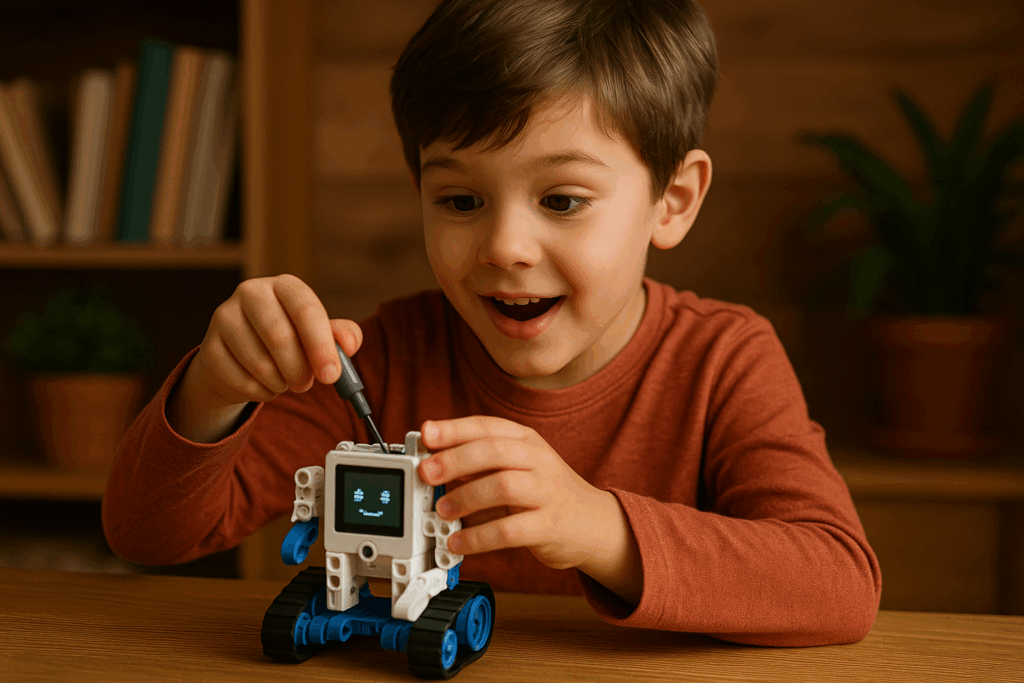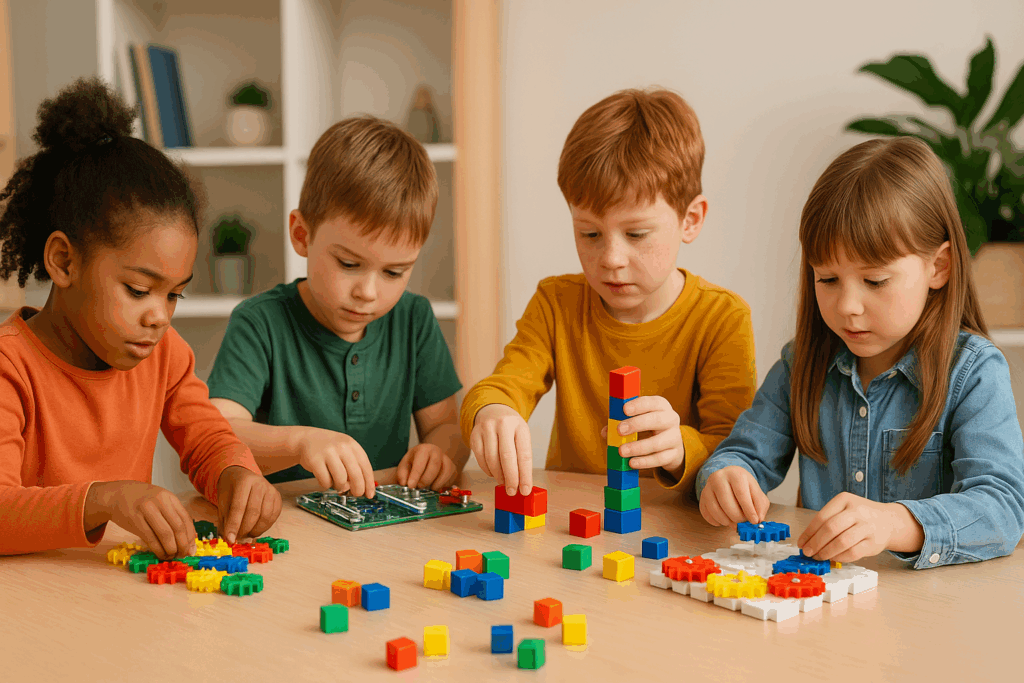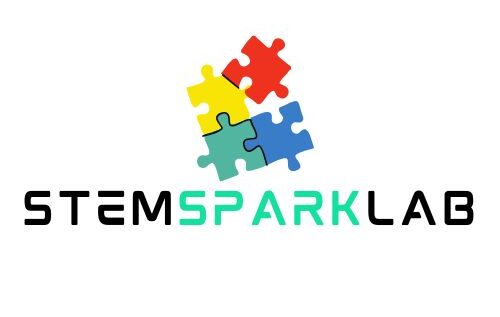Pros of Hands-On STEM Learning for Kids’ Early Development
We may earn a commission for purchases made using our links. Please see our disclosure to learn more.
STEM learning—short for science, technology, engineering, and math—is becoming essential in early education. More than just academic prep, it encourages creativity, builds resilience, and shapes problem-solvers from a young age.
Introduction: Why STEM Learning Matters Early On
Children are inherently inquisitive. They enjoy asking “why,” disassembling objects, and observing the results of mixing, constructing, or breaking things. The goal of experiential STEM education is to stimulate such curiosity.
STEM encompasses more than just creating apps and building robots, while those are important aspects of the field. It’s all about igniting an exploratory attitude. Children not only learn but also explore, test, question, and develop through practical experiences.
How Hands-On STEM Learning Builds Critical Thinking
Real-World Problem Solving
Activities like building a bridge from straws or testing which materials sink or float push children to think logically and evaluate outcomes. It’s not about right or wrong—it’s about finding what works, why it works, and how to improve it.
Trial and Error Encouragement
In STEM, failure isn’t the end—it’s a lesson. When kids see that errors are part of the process, they become more confident and persistent, building essential problem-solving skills.

Boosts Creativity and Curiosity
Open-Ended Projects
Give a child some pipe cleaners, craft sticks, and a goal like “build a structure.” Suddenly, their imagination becomes the blueprint.
Encourages Questioning
STEM invites questions. “Why did it fall?” “What if we try this instead?” These questions open the door to deeper learning and discovery.
Enhances Fine Motor Skills and Coordination
Whether they’re assembling circuits or stacking gears, kids are constantly refining motor skills during STEM play. These actions support development in writing, drawing, and even sports.
Promotes Teamwork and Communication
STEM projects are often collaborative. Sharing tools, taking turns, or working together to build something promotes not only social skills but also empathy, leadership, and communication.
Fosters Early Interest in Future Careers
Exposing children to STEM at a young age shows them what’s possible. Girls see they can be engineers. Boys get excited about biology or climate science. It plants the seed for future careers in high-demand fields—without pressure, just play.
Strengthens Academic Foundations
STEM naturally blends key academic subjects:
- Science: through experiments and observations
- Technology: by using gadgets or basic coding tools
- Engineering: by building structures
- Math: by measuring, counting, and problem-solving
This integration makes learning more engaging and easier to retain.
Encourages Independent Learning
Hands-on STEM activities help kids take ownership of their learning. They set goals, test their ideas, and learn from what happens. That kind of autonomy builds motivation and confidence.
What the Research Says About Early STEM Learning
The power of hands-on STEM learning isn’t just anecdotal—it’s well-documented by research.
Increased Motivation Through Tactile Learning
A study in SAGE Open found that preschoolers engaging in tactile science activities showed significantly more enthusiasm and interest in learning. Letting kids physically manipulate objects—like mixing, stacking, or testing—helps them absorb and enjoy complex concepts.
Creativity Boosted by Integrating Arts with STEM
A literature review on STEAM in early education concluded that blending art with traditional STEM subjects encourages cognitive flexibility and innovation. This holistic approach makes STEM feel less intimidating and more engaging.
Advanced Tools Spark Deeper Curiosity
As kids mature in their STEM journey, their curiosity often expands beyond basic kits. Tools like thermal imaging drones add excitement and real-world relevance. Kids can learn about heat mapping, rescue tech, and environmental studies all from a hands-on drone experience.
👉 Explore how thermal imaging drones are transforming hands-on STEM learning
Recommended STEM Learning Products for Kids
Here are five fantastic kits that make STEM fun, engaging, and age-appropriate:
1. KiwiCo STEM Crates
Hands-on monthly projects designed by educators and engineers for ages 5+. One standout is the jumping robot crate.
2. Learning Resources Gears! Gears! Gears! Super Building Set
Bright, colorful gears that help kids understand cause and effect while improving hand-eye coordination.
3. Snap Circuits Jr. SC-100 Electronics Exploration Kit
Over 100 projects that teach basic electrical engineering principles—no soldering needed.
4. Botley 2.0 – The Coding Robot Activity Set
A screen-free coding robot that teaches logic, sequencing, and creative problem-solving.
5. National Geographic Mega Science Lab
Combines geology, chemistry, and physics experiments into one powerful learning kit.

Conclusion: Start Early, Grow Bold
Hands-on STEM learning isn’t just an educational tool—it’s a launchpad. The earlier you introduce kids to the joy of discovery, the more likely they are to grow into confident, curious thinkers.
So whether you’re a parent, teacher, or caregiver, consider setting up a STEM corner at home or gifting a science kit. That one small action could open a lifetime of possibilities.
Frequently Asked Questions
1. What age is best to introduce STEM learning to kids?
The best time to begin is in preschool. Many STEM kits are designed for ages 3 and up.
2. Do I need to know STEM myself to teach it?
Not at all. Most kits are user-friendly and include clear instructions—perfect for learning together.
3. How often should kids engage in STEM?
A couple of hands-on sessions per week can make a noticeable difference in skills and engagement.
4. Can STEM really help with school performance?
Yes—especially in math and science, but also in areas like reading comprehension and logical thinking.
5. Are there screen-free options?
Definitely. Many kits, like building sets or robotics with cards, don’t require screens at all.




